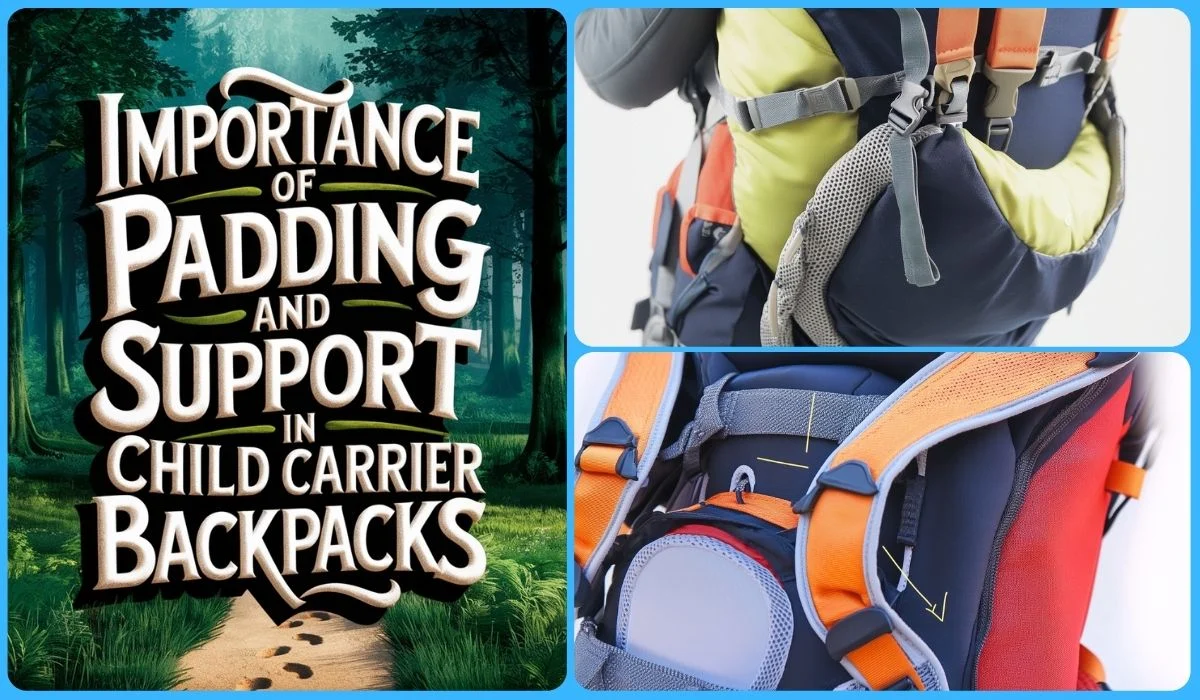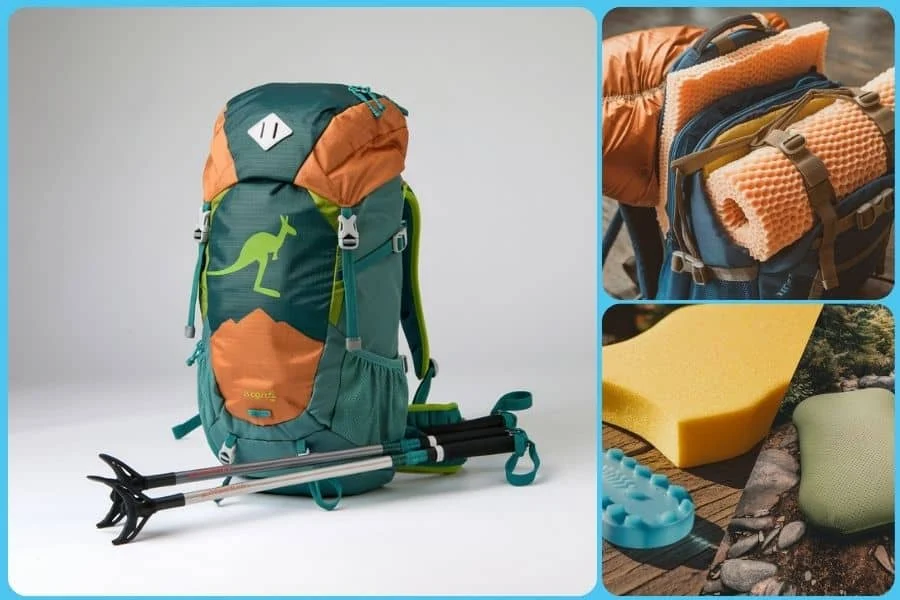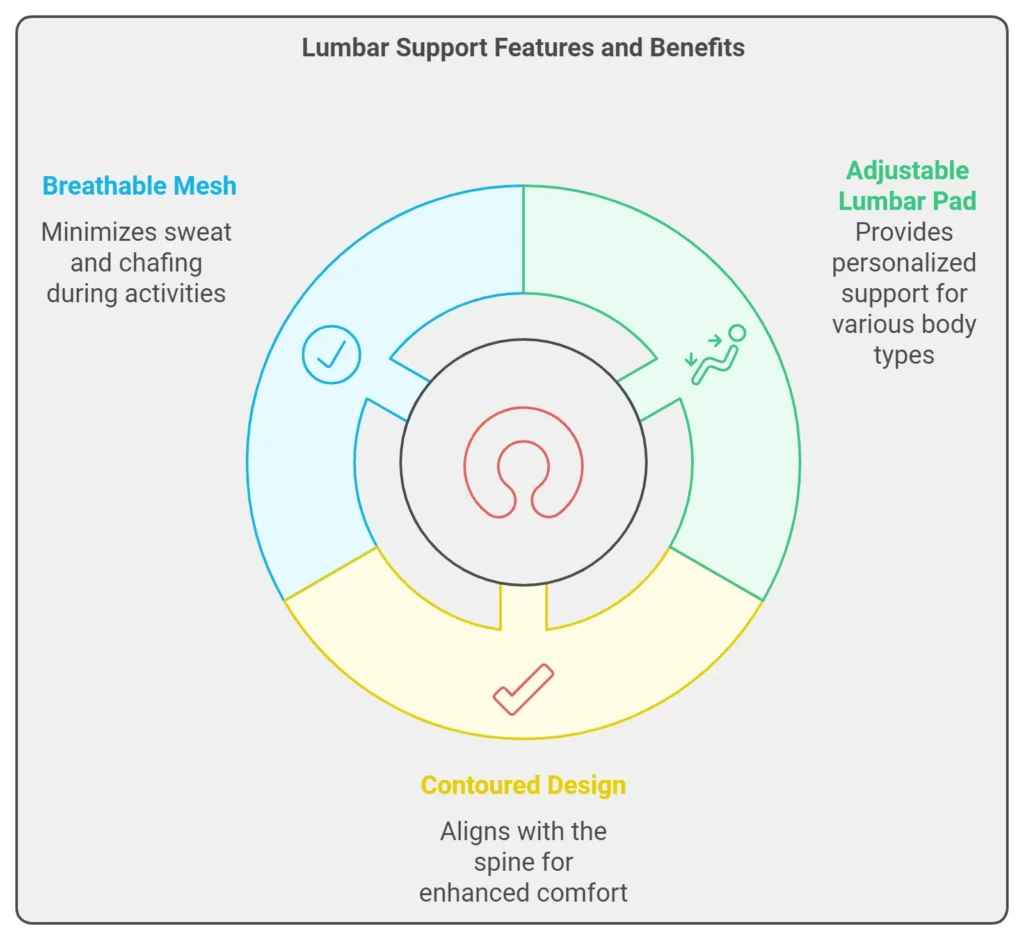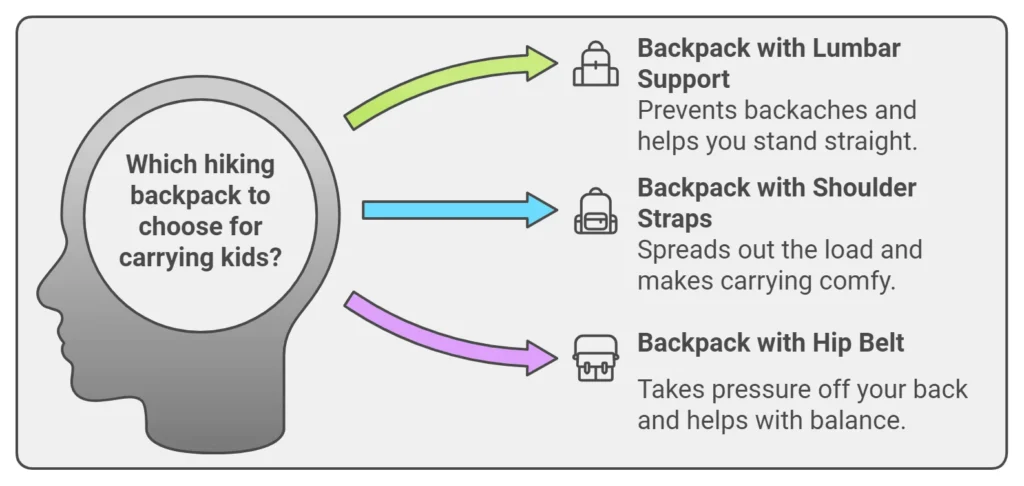
Did you know that 68% of hiking injuries with child carriers come from poor support and padding?
The right hiking backpack can make or break your outdoor adventure with your little one.
Parents often struggle with back pain and shoulder strain during long hikes because they choose carriers without proper padding and support features.
Your child’s comfort and safety and your physical well-being should not be compromised.
This guide will show you how to choose the perfect outdoor carrier.
You will learn the essential features of a safe baby backpack.
What you’ll discover:
- Key padding zones for maximum comfort
- Weight distribution techniques
- Safety harness requirements
- Adjustable support systems
- Material durability standards
Ready to hit the trails confidently?
Let’s ensure both you and your little hiker stay comfortable and secure every step of the way.
Key Components of Child Carrier Backpacks
When choosing a child carrier backpack, it’s important to understand its main parts.
Let’s examine why these backpacks work so well for parents and kids.

1. Frame Structure
The frame of a child carrier backpack is like its skeleton. It keeps everything in place and helps you carry your child safely.
- Materials:
- Aluminum: Light and strong
- Plastic: Tough and doesn’t rust
- Benefits:
- Gives the backpack its shape
- Helps spread out the weight
- Makes the backpack last longer
The frame is super important because it helps you carry your child without hurting your back.
It keeps the backpack steady, even when walking on bumpy trails.
| Feature | Purpose |
| Rigid frame | Provides stability |
| Adjustable height | Fits different adult sizes |
| Weight distribution | Reduces strain on the back |
2. Seat and Harness System
The seat and harness keep your child safe and comfy in the backpack.
- Seat design:
- Padded for comfort
- Can be adjusted as your child grows
- Supports good posture for your child
- Harness features:
- 5-point harness (like in a car seat)
- Keeps your child from falling out
- Can be adjusted to fit snugly
A good seat and harness system are key to a happy hike. It prevents your child from moving around too much, which could throw you off balance.
3. Parent’s Carrying System
This part of the backpack is about making it comfortable for the adult.
- Comfort features:
- Padded shoulder straps
- Wide hip belt to spread out weight
- Chest strap for extra support
- Adjustability:
- Straps can be made longer or shorter
- The hip belt can be tightened or loosened
- Helps fit different body shapes

Many backpacks also have:
- Breathable back panels to keep you cool
- Pockets for water bottles and snacks
- Places to attach extra gear
You can hike longer without getting tired by choosing a backpack with good parent comfort features.
The Importance of Support and Padding in Child Carrier Hiking Backpacks
Did you know that 85% of hikers report better comfort with proper padding?
Let’s explore why support and padding matter in child carrier hiking backpacks:
- They ensure your child’s safety and comfort.
- They reduce strain on your back and shoulders.
- They make long hikes more enjoyable for everyone.
Ready to choose the best carrier for your outdoor adventures? Read on!
Types of Padding Materials
Choosing the right padding can make or break your hiking experience. Here’s what you need to know:

- Foam: Lightweight and durable
- Gel offers superior shock absorption.
- Breathable fabrics: Keep you and your child calm.
Ergonomic padding uses impact-resistant materials to protect your child.
Look for moisture-wicking fabrics to keep them dry on long treks.
Strategic Padding Placement
Where padding goes matters as much as what it’s made of. Optimal distribution is key:
- Shoulder straps: Prevent digging and chafing.
- Waist belt: Supports your lower back.
- Child seat: Cushions your little adventurer.
Balanced weight distribution targets pressure points for a secure fit. This ergonomic design keeps both you and your child comfortable mile after mile.
Impact on Weight Distribution
Smart padding does more than cushion—it helps manage weight. Here’s how:
- Distributes the load evenly across your body.
- Maintaining your center of gravity.
- Align your spine for better posture.
Good weight distribution reduces fatigue, letting you hike longer and enjoy more. With the right carrier, the extra weight will feel insignificant.
Support Systems
When you’re carrying your little hiker, comfort is key! Did you know that 70% of hikers report less fatigue with proper support?
Let’s look at the parts of a child carrier that keep you and your kids happy on the trail. It’s like building the perfect treehouse—every piece matters!

Lumbar Support: Your Back’s Best Friend
Have you ever had a backache after carrying something heavy? Lumbar support is like a cushiony hug for your lower back. Here’s what to look for:

- Curved design that follows your spine’s natural shape
- Adjustable padding for a custom fit
- Breathable materials to keep you cool
What it does:
- Stops your back from getting sore
- Helps you stand up straight, like a superhero
- Makes carrying your child feel easier
Different carriers have different kinds of lumbar support. Some are firm; others are squishy.
The best ones can be adjusted to fit your back just right.
It’s like having a custom-made pillow for your adventures!
| Feature | Benefit |
| Adjustable lumbar pad | Customized support for different body types |
| Contoured design | Follows natural spine curve for better comfort |
| Breathable mesh | Reduces sweat and chafing on long hikes |
Shoulder Strap Design: Comfort for Your Upper Body
Shoulder straps are super important. They’re like the handles on your favorite lunchbox but way comfier! Here’s why they matter:
- They bear most of the weight
- Good design prevents shoulder and neck pain
- Adjustability ensures a perfect fit
What to look for:
- Thick padding that feels like clouds
- Wide straps that spread out the weight
- Straps you can make longer or shorter
Good shoulder straps allow you to carry your child longer without getting tired.
They also help make your little one’s weight feel more like a gentle hug than a heavy load.
Hip Belt: Your Secret Weapon
The hip belt is like a magic trick for making weight disappear! It moves your child’s heaviness from your shoulders to your hips.

Here’s why it’s incredible:
- Transfers weight from shoulders to hips
- Improves balance and stability
- Reduces overall fatigue
Look for a wide and padded hip belt. It should feel snug around your hips, like a comfy hug.
The best ones can be adjusted to fit just right, whether tall, short, or in between.
Here’s a simple table to help you remember the key parts:
| Part | What it Does | Why it’s Important |
| Lumbar Support | Supports your lower back | Prevents backaches and helps you stand straight |
| Shoulder Straps | Carry weight on your shoulders | Spread out the load and make carrying comfy |
| Hip Belt | Moves weight to your hips | Takes pressure off your back and helps with balance |
Remember, the right support system makes hiking with kids a joy, not a chore!
You and your little explorer can go on more significant, longer adventures with these three super-helpers.
It’s like giving yourself carrying superpowers!
Child Safety and Comfort Features
When you’re taking your little buddy on an adventure, you want them to be as comfy as possible, right?
Let’s check out some cool features that keep your kiddos safe and happy in their career.
Adjustable Seat Height
Imagine if your chair at school was way too big or too small. It would be no fun, right?
That’s why child carriers have seats that can change size!
Why it is good:
- Fits kids of different sizes, like a magic chair
- Keeps your child snug and secure, like a gentle hug
- Grows with your child, so you don’t need a new carrier every year
The best carriers have seats that are super easy to adjust.
You can move them up or down like an elevator for your child.
And don’t worry—once you find the perfect spot, they have special locks to keep the seat in place.
Head and Neck Support
Understanding how to carry a toddler while hiking safely is crucial, especially for babies still working on holding their heads up.
That’s where head and neck support comes in!
- What it does:
- Cradles your child’s head like a soft pillow
- Stops their head from bouncing around on bumpy trails
- Helps your child take comfy naps while you hike
Some carriers have head supports you can take off when your child gets bigger.
Others let you move them around to find the perfect spot.
It’s like giving your child a customized headrest for their outdoor adventures!
According to pediatric guidelines for baby carriers, proper head and neck support is crucial for infants under 4 months.
Leg Positioning and Stirrups
Have you ever sat in a chair where your feet didn’t touch the ground? Not very comfy, right?
That’s why child carriers have special features for little legs!
- Cool things to look for:
- Seats that let your child’s legs hang in a comfy position
- Little “footrests” called stirrups for longer trips
- Padding to stop legs from getting sore
The best carriers let you move these parts around as your child grows.
It’s like having a career that grows with your little adventurer!
Here’s a simple table to help you remember these essential features:
| Feature | What it Does | Why It’s Important |
| Adjustable Seat Height | Changes to fit your child | Keeps them comfy and secure as they grow |
| Head and Neck Support | Hold your child’s head gently | Protects their neck and helps them sleep |
| Leg Positioning and Stirrups | Gives comfy spots for legs and feet | Stops legs from getting tired or sore |
With these excellent features, your child will be ready for outdoor fun.
Ventilation and Temperature Regulation
You must stay cool and comfy when you’re on an adventure with your little buddy.
Let’s look at some awesome features that help you and your child feel right, regardless of the weather!
Breathable Materials
Imagine wearing a raincoat on a hot day – yuck! That’s why child carriers use special fabrics that let air flow through.
- Cool fabrics to look for:
- Mesh: Like the stuff on sneakers, it has tiny holes for air
- Nylon: Light and breezy, like your favorite summer shirt
- Special fabrics that move sweat away from your skin
These materials work like magic to keep you and your child from getting too hot and sweaty.
It’s like having a personal fan built into a child carrier!
Airflow Design Features
Carriers use clever tricks to keep air moving. It’s like giving your backpack superpowers to fight against heat!
- Awesome air-moving features:
- Air channels: Little paths for air to flow, like tiny rivers of coolness
- Mesh panels: Big areas of breathable fabric to let heat escape
- Spaces between you and the carrier: So air can move around freely
These features work together to keep both you and your child cool.
It’s like having a gentle breeze following you on your hike!
Weather Protection Options
For those unexpected weather changes, a waterproof toddler backpack can keep your little one dry and comfortable.
Many carriers have ways to keep your child comfy in all kinds of weather.
- Weather-beating add-ons:
- Rain covers: Like a tiny raincoat for the carrier
- Sunshades: A personal umbrella to block harmful sun rays
- Cozy liners: To keep your child warm on chilly days
These extras help you enjoy the outdoors no matter what the sky is doing. It’s like having a weather-proof bubble for your little adventurer!
Here’s a simple table to help you remember these cool features:
| Feature | What it Does | Why It’s Awesome |
| Breathable Materials | Let air flow through | Keeps you both cool and dry |
| Airflow Design | Moves hot air away | Prevents overheating on warm days |
| Weather Protection | Guards against sun, rain, and cold | Lets you explore any weather |
With these amazing features, you and your child can stay comfy on all outdoor adventures.
It’s like having a climate-controlled treehouse you can carry on your back!
Adjustability: One Size Does Not Fit All
Have you ever noticed how some clothes fit perfectly while others don’t? Child carriers work the same way!

Explore how these carriers adapt to fit you and your growing child.
- 90% of hikers report better comfort with adjustable carriers
- Proper fit reduces strain on the back and shoulders
- Adjustability extends the lifespan of your carrier
Discover how these features can transform your hiking experience!
Torso Length Adjustment: Customized Comfort
Torso length adjustment is a game-changer in child carrier backpacks. It’s like having a carrier that grows or shrinks to match your body!

Why it’s cool:
- Makes the carrier fit your back just right, like a custom-made jacket
- Spread out the weight so your back doesn’t get sore
- Helps you stand up straight and feel comfy, even on long hikes
The best carriers let you slide the back panel up and down to find your perfect fit. This customizable fit ensures comfort for hikers of all heights.
| Torso Length | Recommended Adjustment |
| Short (16-17″) | Fully compressed |
| Medium (18-19″) | Mid-range setting |
| Tall (20″+) | Fully extended |
This ergonomic design accommodates different body types, making the carrier comfortable for both parents.
Strap and Harness Customization: Secure and Comfy
Imagine if your shoes could change shape to fit your feet perfectly. That’s what adjustable straps and harnesses do for carriers!
Awesome adjustable parts:
- Shoulder straps: Make them longer or shorter to fit your shoulders
- Chest strap: Slides up and down to find the comfiest spot
- Hip belt: Ensures proper load distribution
- Child’s harness: Grows with your kiddo to keep them snug and safe
These parts usually have easy-to-use buckles and sliders.
It’s like playing with LEGO, but you’re creating the perfect carrier instead of building a toy!
Key customization points optimize load distribution and ensure a secure fit.
Look for carriers with safety harness features that are easy to adjust as your child grows.
Growing with Your Child: Long-Term Value
Kids grow super fast, right? Suitable carriers can keep up with all that ever-increasing!
How they adapt:
- Seats that get bigger as your child does
- Leg holes that can be made wider
- Head supports that can be moved or taken off
By changing with your child, these carriers save you from buying a new one every few months. It’s like having a magical backpack that grows along with your little adventurer!
| Child’s Age | Weight Range | Recommended Adjustments |
| 6-12 months | 16-22 lbs | Highest seat position, full support |
| 1-2 years | 22-30 lbs | Mid-level seat, adjusted support |
| 2-4 years | 30-40 lbs | The lowest seat position reduced the support |
Adjustable child carriers offer excellent longevity of use and represent an intelligent investment for outdoor-loving families.
Here’s a simple table to help you remember these adjustable features:
| Feature | What it Does | Why It’s Awesome |
| Torso Length Adjustment | Fits the carrier to your back size | Makes carrying comfy for different-sized adults |
| Strap and Harness Customization | Lets you change all the straps | Fits both you and your child perfectly |
| Growing with Your Child | Carrier changes as your child grows | Saves money and fits your child for years |
With all these extraordinary adjustments, you can make your carrier fit just right, no matter how big or small you and your child are.
It’s like having a shape-shifting backpack that’s always perfect for your adventures!
Durability and Maintenance of Padding and Support

Ever wonder how to keep your child carrier in tip-top shape?
Whether you choose a waterproof toddler backpack or a standard carrier, these backpacks need some TLC to stay comfy and safe.
Let’s dive into how to make your carriers last through countless adventures!
- 95% of long-lasting carriers are well-maintained
- Regular care can double the lifespan of your backpack
- Proper maintenance ensures consistent comfort and safety
Ready to become a pro at carriers care? Let’s explore!
Quality Materials for Longevity: Built to Last
Think of your child carrier like a superhero suit – it must be tough!
Quality materials are the secret to durable padding and long-lasting support.
What makes these materials super:
- Wear resistance: They can take a beating from rocks, branches, and curious little hands
- High-performance fabrics: These wick away sweat and dry quickly, keeping you and your child comfy
- Solid construction: Strong stitching and reinforced stress points prevent tears and breaks
| Material | Benefits | Best For |
| Ripstop nylon | Tear-resistant, lightweight | Outer shell |
| EVA foam | Durable, shock-absorbing | Padding |
| Aluminum frame | Strong, lightweight | Support structure |
Look for carriers that use these challenging materials. It’s like giving your backpack a suit of armor!
Cleaning and Care Tips: Keep It Fresh and Functional
Your carrier will get dirty – that’s part of the adventure! But keeping it clean is vital to making it last.
Here’s how to give your backpack a spa day:
- Read the label: Every carrier has its care instructions. It’s like a recipe for cleanliness!
- Spot clean: For small messes, a damp cloth and mild soap work wonders
- Deep clean: For bigger jobs, hand wash in cool water or use a front-loading machine on a gentle cycle
- Air dry: Never put your carrier in the dryer – hang it up instead
Pro tip: Use a soft brush to remove dirt from zippers and buckles. It’s like giving your carrier a gentle massage!
Stain removal tricks:
- Mud: Let it dry, then brush off and spot clean
- Food: Blot (don’t rub!) with a damp cloth and mild detergent
- Sunscreen: Use a paste of baking soda and water
Remember, proper washing techniques help preserve material integrity.
Treat your carrier right; it’ll return the favor on the trails!
When to Replace or Repair: Safety First
Even superheroes need upgrades sometimes. Knowing when to replace or repair your carrier keeps your adventures safe and comfy.
Signs it’s time for a checkup:
- Worn straps or buckles: These are the seat belts of your carrier!
- Thinning padding: If it feels less cushy, it’s not protecting as well
- Tears or holes: Small ones can be patched; big ones might mean retirement
- Mold or mildew: This can weaken the fabric and isn’t healthy for your little one
Here’s a handy maintenance schedule to keep your carrier in prime condition:
| Frequency | Action |
| After each use | Brush off dirt, air out |
| Monthly | Deep clean, check for wear |
| Annually | Thorough inspection, consider professional servicing |
With proper care, most carriers have a 3-5-year lifespan.
But remember, if you’re ever in doubt about safety, it’s better to replace than risk it!
Repair or replace? Here’s a quick guide:
- Small tears, loose stitching: Repair (it’s like giving your carrier a band-aid!)
- Broken buckles or zippers: Often replaceable (like changing a tire)
- Significant structural damage: Time for a new carrier (think of it as an upgrade)
Pro tip: Keep the warranty info handy. Many companies offer excellent repair services!
By following these tips, you’ll maintain a carrier and preserve countless future adventures with your little one.
Happy trails!
Choosing the Right Child Carrier Backpack
Ready to explore our guide to the best toddler hiking backpacks to find your perfect hiking buddy?
Understanding how to fit a child carrier is crucial for both parent and child comfort.
Choosing the right child carrier backpack is like picking a trusty sidekick for your adventures.

Let’s walk through how to find the carrier to make you and your little explorer happy campers!
- 85% of hikers say the suitable carrier makes all the difference
- A well-chosen carrier can last through multiple children
- Proper fit increases hiking enjoyment for parent and child
Are you excited to start your carrier quest? Let’s dive in!
Assessing Your Needs and Activities: What’s Your Adventure Style?
Before you start shopping, consider your hiking habits.
It’s like planning a trip—you need to know where you’re going to pack the right gear!
Consider these factors:
- Hiking frequency: Weekend warrior or daily trailblazer?
- Terrain types: Smooth paths or rocky mountains?
- Child’s age and weight: Tiny tot or growing explorer?
Here’s a handy guide to match your style:
| Hiking Style | Recommended Carrier Features |
| Occasional, short hikes | Lightweight, basic support |
| Frequent, long treks | Heavy-duty, extra storage |
| Varied terrain | Excellent stability, adjustable suspension |
Remember, your lifestyle plays a significant role too.
A carrier that works for urban nature walks might not cut it for backcountry adventures!
Pro tip: Make a list of your must-have features. It’s like creating a wishlist for your dream carrier!
Budget Considerations: Invest in Comfort and Quality
Let’s talk money, honey! Child carriers come in all price ranges, but remember – this is an investment in your family’s outdoor fun.
Price ranges to consider:
- Budget-friendly ($100-$200): Great for occasional hikers
- Mid-range ($200-$300): Good balance of features and price
- Premium ($300+): Top-notch comfort and durability
Think of it this way:
- Cheap carrier + uncomfortable hike = Sad parent and cranky kid
- Quality carrier + comfy adventure = Happy trails for all!
Cost-effective options to consider:
- Look for last year’s models – often on sale!
- Consider gently used carriers – many kids outgrow them before wearing them out.
- Check for bundle deals with accessories included.
Remember, a suitable carrier can last through multiple children or even be resold.
It’s like buying a quality tent – the initial cost pays off in the long run!
Try Before You Buy Tips: Test Drive Your Top Picks
Imagine buying shoes without trying them on – yikes! The same goes for child carriers.
Here’s how to get hands-on experience before committing:
- Visit outdoor gear stores: They often have weighted dummies to simulate your child
- Attend fitting sessions: Some retailers offer expert advice to find your perfect fit
- Borrow from friends: Nothing beats a real-world test (with your actual wiggle worm!)
What to check during your trial:
- Comfort: Walk around for at least 15 minutes
- Adjustability: Can you easily tweak the fit?
- Child’s comfort: Is the seat padded and positioned well?
- Accessibility: Can you reach snacks and water without gymnast-level flexibility?
| Test | What to Look For |
| Strap adjustment | Ease of use, range of sizes |
| Weight distribution | Even feel across shoulders and hips |
| Child security | Snug harness, sturdy kickstand |
Pro tip: Wear the clothes you typically hike in during your trial. It’s like a dress rehearsal for your adventures!
Don’t be shy about asking retailers for recommendations. They’re like matchmakers for hikers and carriers!
Remember, the perfect carrier feels like an extension of yourself.
When you find “the one,” you’ll know – it’s like Cinderella finding her glass slipper, but way more practical for hiking!
By taking the time to assess your needs, consider your budget, and try before you buy, you’re setting yourself up for miles of happy trails with your little one.
Happy carrier hunting!
Expert Recommendations and Reviews
Ready to hear from the pros?
Let’s explore what experts and real parents have to say about kids hiking backpacks and carriers.
It’s like getting insider tips before your big adventure!
- 93% of hikers trust expert reviews when choosing a carrier
- Top-rated carriers consistently score high in comfort and durability
- Real parent experiences offer practical insights you won’t find in product descriptions
Let’s explore!
Top-Rated Child Carrier Backpacks: The Crowd Favorites
Here are some of the best child carrier backpacks currently available, and their price ranges are based on Amazon listings.
Osprey Poco Plus:
- Known for: Exceptional comfort and ample storage
- User rating: 4.8/5 stars
- Price Range: $224.00
The Osprey Poco Plus is highly regarded for its comfortable design and thoughtful features, including a built-in sunshade and adjustable torso fit.
Deuter Kid Comfort:
- Known for: Superior comfort and ease of use
- User rating: 4.7/5 stars
- Price Range: $290.00
The Deuter Kid Comfort offers a secure five-point harness and excellent weight distribution, making it a favorite among parents for longer hikes.
Kelty Journey Perfectfit:
- Known for: Versatility and affordability
- User rating: 4.6/5 stars
- Price Range: $189.99
The Kelty Journey Perfectfit is praised for its adjustable fit and lightweight design, making it suitable for various outdoor adventures.
Summary of Features and Prices:
| Carrier | Best For | Price Range |
|---|---|---|
| Osprey Poco Plus | Long hikes, heavy loads | $224.00 |
| Deuter Kid Comfort | All-day comfort, toddlers | $270.00 |
| Kelty Journey Perfectfit | Versatility, affordability | $189.99 |
Selecting the right carrier depends on your specific needs, such as the duration of hikes and your child’s age. Always consider user reviews and ratings to ensure you are making an informed choice.
Conclusion
Happy Trails are more fun with the proper padding and support. Child carrier backpacks need good cushioning to keep kids comfy. A proper fit is critical for both parents and children. This ensures everyone stays safe on the trail.
Comfortable hiking gear makes family outdoor fun possible. With quality padding, you can go on longer adventures. Your child will enjoy the ride, and you’ll feel good too. Safe adventures start with the right equipment.
Don’t let fear hold you back. Grab a well-padded carrier and hit the trails. Enjoyable family outings are waiting for you. Make memories that last a lifetime. Start your Happy Trails journey today!





